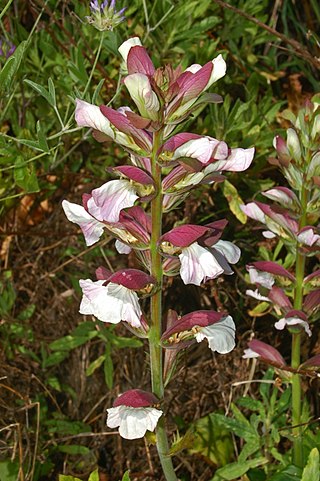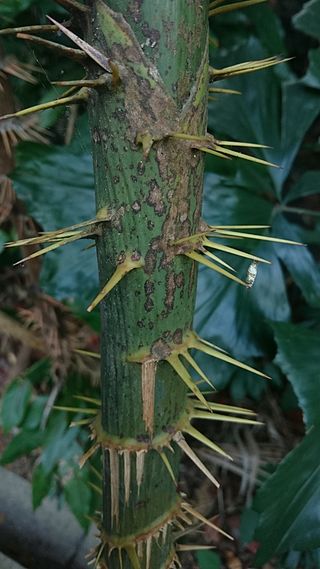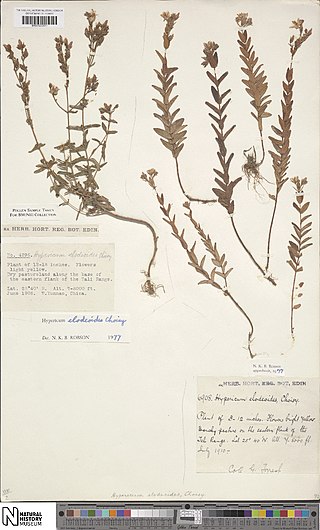
Cardamine is a large genus of flowering plants in the mustard family, Brassicaceae, known as bittercresses and toothworts. It contains more than 200 species of annuals and perennials. Species in this genus can be found in diverse habitats worldwide, except the Antarctic. The name Cardamine is derived from the Greek kardaminē, water cress, from kardamon, pepper grass.

Cotinus coggygria, syn. Rhus cotinus, the European smoketree, Eurasian smoketree, smoke tree, smoke bush, Venetian sumach, or dyer's sumach, is a Eurasian species of flowering plant in the family Anacardiaceae.

Acanthus mollis, commonly known as bear's breeches, sea dock, bear's foot plant, sea holly, gator plant or oyster plant, is a species of plant in the family Acanthaceae and is native to the Mediterranean region. It is a leafy, clump-forming perennial herb, with a rosette of relatively large, lobed or toothed leaves, and purplish and white flowers on an erect spike.

Cardamine pratensis, the cuckoo flower, lady's smock, mayflower, or milkmaids, is a flowering plant in the family Brassicaceae. It is a perennial herb native throughout most of Europe and Western Asia. The specific name pratensis is Latin for "meadow".

Cardamine hirsuta, commonly called hairy bittercress, is an annual or biennial species of plant in the family Brassicaceae, and is edible as a salad green. It is common in moist areas around the world.

Ipomoea indica is a species of flowering plant in the family Convolvulaceae, known by several common names, including blue morning glory, oceanblue morning glory, koali awa, and blue dawn flower. It bears heart-shaped or 3-lobed leaves and purple or blue funnel-shaped flowers 6–8 cm (2–3 in) in diameter, from spring to autumn. The flowers produced by the plant are hermaphroditic. This plant has gained the Royal Horticultural Society's Award of Garden Merit.

Eleiodoxa is a monotypic genus of flowering plant in the palm family found in Southeast Asia. The only species, Eleiodoxa conferta, is a dioecious, swamp-dwelling plant, commonly called by Malay as asam kelubi or asam paya. While five species names have been published, the other four are usually recognized as synonyms of the lectotype E. conferta. The genus is named from two Greek words meaning "water" and "glory" and the species name is Latin for "congested", an allusion to the flower spike.

Iguanura is a monoecious genus of flowering plant in the palm family from Southeast Asia, commonly called pinang. Closely related to the Heterospathe palms, they are noted for producing a wide variety of fruit forms. Its name combines the Spanish word for "lizard" with the Greek word for "tail".
Laccosperma is a clustering genus of flowering plant in the family palm found in tropical Africa. Poorly studied and rarely cultivated, they are closely related to the genus Eremospatha and with it form a tribe in the Calameae characterized by dyads of hermaphrodite flowers. The genus name combines the Greek words for "reservoir" and "seed".

Myrialepis is a monotypic genus of flowering plant in the palm family, the single species, Myrialepis paradoxa, native to Southeast Asia. The genus name is a combination of the Greek words meaning "innumerable" and "scale", a description of the fruit, and the epithet is Latin for "paradox".

Roystonea borinquena, commonly called the Puerto Rico royal palm, is a species of palm which is native to Hispaniola, Puerto Rico and the Virgin Islands.

Elaeocarpus bancroftii, commonly known as Kuranda quandong, Johnstone River almond, ebony heart, grey nut, or nut tree is a large rainforest tree in the family Elaeocarpaceae which is endemic to Queensland. It has coriaceous leaves, attractive white flowers and relatively large fruit containing an edible kernel.

Gompholobium latifolium, commonly known as golden glory pea or broad-leaved wedge-pea, is a plant in the pea family Fabaceae and is endemic to eastern Australia. It is a small shrub with leaves composed of three leaflets and which has relatively large yellow flowers in spring and early summer.

Iberis umbellata, common name garden candytuft or globe candytuft, is a herbaceous annual flowering plant of the genus Iberis and the family Brassicaceae.

Crocosmia aurea, common names falling stars, Valentine flower, or montbretia, is a perennial flowering plant belonging to the family Iridaceae.
Dodecadenia is a botanical genus of flowering plants in the family Lauraceae. It contains a single species, Dodecadenia grandiflora. It is present from central Asia, to Himalayas and India. It is present in tropical and subtropical montane rainforest, laurel forest, in the weed-tree forests in valleys, mixed forests of coniferous and deciduous broad-leaved trees, Tsuga forests; 2,000–2,600 metres (6,600–8,500 ft) in China in provinces of Sichuan, Xizang, Yunnan, and countries of Bhutan, India, Myanmar, and Nepal.

Rheum webbianum is a species of herbaceous perennial rhubarb-relative in the family Polygonaceae from the southwestern Himalayan region, known in (Indian) English as Indian rhubarb, Gilgiti rhubarb or small Himalayan rhubarb.

Hakea lasianthoides is a shrub or tree in the family Proteaceae and is endemic to Western Australia. It has creamy-white flowers, mostly linear leaves and flowers from September to November.

Hakea macrocarpa, commonly known as dogwood hakea, is a shrub or tree in the family Proteaceae. It has cream-yellow flowers from May to June. It is native to Western Australia and the Northern Territory.

Hypericum elodeoides, commonly called the Himalayan St. John's Wort, is a species of flowering plant of the St. John's wort family (Hypericaceae).






















